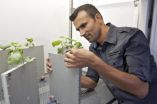Across the Horn, drought-induced famine has claimed tens of thousands of lives and swelled refugee camps in Kenya, Ethiopia and elsewhere, with millions of starving people – many of them children. Bearing the brunt of the crisis is Somalia, which not coincidentally is also a country that has lost a significant amount of its forests.
Experts say forest destruction and other forms of human-caused land degradation have done far more than the drought to turn vast areas of once grazeable and farmable land into a lunar-like landscape.
"Forests and trees frequently form the basis of livelihood diversification, risk-minimization and coping strategies, especially for the most vulnerable households such as those led by women," said Frances Seymour, director general of the CGIAR's Center for International Forestry Research (CIFOR).
"However, deforestation and land degradation have hindered capacities to cope with disasters and adapt to climate variability and change in the long-term."
New research by CIFOR carried out in 25 countries worldwide has shown that forests serve as a crucial defense against poverty, providing about a quarter of household income for the people living in or near them. Forests in perennially parched areas of the Horn are critical to retaining moisture and nutrients in the soil, while offering a bulwark against wind erosion. They also provide sources of food and fuel, particularly in tough times.
"There is a mistaken view that because these are dry areas, they are destined to provide little in the way of food and are simply destined to endure frequent famines," said Dennis Garrity, director general of the World Agroforestry Centre (ICRAF).
"But drylands can and do support significant crop and livestock production. In fact, the famine we are seeing today is mainly a product of neglect, not nature."
Forest and agroforestry experts say the famine should prompt significant new investments in proven approaches to reforestation and agroforestry that elsewhere in Africa are restoring forests as protectors of drylands and providing important sources of food and other valuable agriculture products.
For example, in Niger, a program launched in 1983 has transformed 5 million hectares of barren land into agroforests. ICRAF experts found that during the drought that hit the country in 2005, farmers who embraced agroforestry were able to sell trees for timber and use the money to buy food. They also were able to supplement their diets with fruits and edible leaves harvested from drought-resistant trees.
In Ethiopia, reforestation projects known as Farmer Managed Natural Regeneration (FMNR), implemented by the World Bank and World Vision, are restoring some 2,700 hectares of degraded land. The projects already are providing income-generating wood and tree products for local communities, improving pasture and achieving a drastic reduction in soil erosion.
Meanwhile, using trees in a wider variety of farm applications is rapidly making agroforestry a popular approach to improving food production in the drylands of Africa. So-called "fertilizer trees" that capture nitrogen from the atmosphere and deposit it into the soil are being used to restore degraded farmlands in Malawi, Zambia, Kenya, Tanzania, Niger and Burkina Faso.
There are also a wide range of naturally growing trees suitable for livestock consumption that have long been used by livestock keepers in sub-Saharan Africa, particularly in the dry season when grass and crop residues are scarce.
"We need to pay far more attention to the role of forests and trees to serve both as protectors of productive farm lands and as ways to sustainably and substantially increase food security in the Horn," said Lloyd Le Page, CEO of the CGIAR Consortium, who sees the food crisis in the region as a call to action for agricultural innovation. He noted that the intensified focus on the link between forests and food security is part of a wider effort within the CGIAR to approach farms as agriculture ecosystems that depend upon and contribute to the health of broader landscapes.
Scientists are concerned that despite clear evidence of their benefits – and of the disasters that occur in the wake of their loss – dryland forest protection and restoration is receiving scant attention compared to humid forest preservation. They point out that this disparity is particularly evident within discussions of climate change adaptation and mitigation.
"It's ironic that dryland forests are not front and center in the climate change debate, because climate change is likely to bring more frequent and more severe droughts to dryland areas, and the adaptation challenge for affected communities will be great," Seymour said.
She also noted that protection of both dryland and humid forests can reduce the likelihood of future climate change-induced droughts through mitigation of forest-based greenhouse gas emissions. Humid forests in particular serve as vast "sinks" that absorb and store carbon and thus help slow the pace of climate change in the long term, but there are also many opportunities to maintain and enhance the amount of carbon stored in dryland landscapes.
###
The Center for International Forestry Research (CIFOR) advances human well-being, environmental conservation and equity by conducting research to inform policies and practices that affect forests in developing counties. CIFOR helps ensure that decision making that affects forests is based on solid science and principles of good governance, and reflects the perspectives of developing countries and forest-dependent people. CIFOR is one of 15 centres within the CGIAR. For more information, please visit: www.cifor.cgiar.org.
The World Agroforestry Centre (ICRAF) is an autonomous, non-profit research organisation whose vision is a rural transformation in the developing world, resulting in a massive increase in the use of trees in rural landscape by smallholder households for improved food security, nutrition, income, health, shelter, energy and environmental sustainability. The Centre generates science-based knowledge about the diverse roles that trees play in agricultural landscapes, and uses its research to advance policies and practices that benefit the poor and the environment. We are one of the 15 centres of the CGIAR. www.worldagroforestrycentre.org
END


